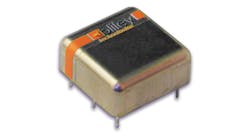Low-Power OCXOs Take Flight in LEOS Systems
Download this article as a .PDF
Running out of power in a satellite can be costly, since changing batteries is no simple matter. Fortunately, advances made by Bliley Technologies on its Iris line of oven-controlled crystal oscillators (OCXOs) have instilled the traditional stability of OCXOs without the traditionally high power consumption.
Available with sinewave or HCMOS-level outputs, the product family includes high radiation tolerance, low phase noise, and excellent acceleration sensitivity with output frequencies reaching 100 MHz. The Iris OCXOs are designed for long running times in low-Earth-orbit satellites (LEOS) or any application where power consumption is a concern, including unmanned aerial vehicles (UAVs).
One example of a LEOS master reference oscillator available in the Iris line is model NV45AY (see figure), a 100-MHz sinewave Iris OCXO designed to handle the radiation exposure typical of LEOS, both total ionizing dosage (TID) and linear energy transfer (LET). It is radiation-tolerant to 40 krad TID and 40 MeV LET. For space use, it also boasts 0.3 ppb/g acceleration sensitivity. Model NV45AY provides +10 dBm typical output power at 100 MHz with 1.5-W typical steady-state power consumption from a +5-V dc supply. Power consumption at startup is only 2.5 W, with a maximum warmup time of about 3 min.
The NV45AY OCXO is well-suited for battery-powered electronic devices, such as commercial and military portable radios, and even in guidance/navigation devices that require accurate timing but Global Positioning System (GPS) coverage may not be available. Maximum harmonic and spurious levels into a 50-Ω load are ‒30 and ‒80 dBc, respectively. Room-temperature (+25ºC) phase noise for the model NV45AY is quite impressive, with worst-case values at ‒95 dBc/Hz offset 10 Hz from the carrier, ‒125 dBc/Hz offset 100 Hz, ‒155 dBc/Hz offset 1 kHz, ‒168 dBc/Hz offset 10 kHz from the carrier, and ‒168 dBc/Hz offset 100 kHz from the carrier.
All members of the Iris line come in surface-mount-technology (SMT) housings measuring 0.5 × 0.5 in. They can be designed for supply voltages of +3.3 V dc ±5% or +5.0 V dc ±5%.
The oscillators are available with various grades of frequency-versus-temperature performance: ±25, 50, 75, or 100 ppb from ‒20 to +70ºC, or ±75 or 100 ppb from ‒40 to +85ºC. The aging rate is ±100 ppb within one minute for the first year and ±500 ppb within one minute for the first 15 years, both per MIL-PRF-55310. The Allan deviation for frequency versus load is ±5 ppb; for frequency versus voltage, it is also ±5 ppb. They are equipped with electronic frequency control from typically 0 to +4 V dc for a frequency tuning range of ±2 ppm.
Whether with HCMOS or sinewave outputs, the Iris OCXOs provide clean, stable output signals for a fraction of the power consumption of traditional OCXOs. They also add little in weight and size to a circuit design, and help keep satellites stay on time.
Bliley Technologies Inc., 2545 Grandview Blvd., Erie, PA 16506; (814) 838-3571
About the Author
Jack Browne
Technical Contributor
Jack Browne, Technical Contributor, has worked in technical publishing for over 30 years. He managed the content and production of three technical journals while at the American Institute of Physics, including Medical Physics and the Journal of Vacuum Science & Technology. He has been a Publisher and Editor for Penton Media, started the firm’s Wireless Symposium & Exhibition trade show in 1993, and currently serves as Technical Contributor for that company's Microwaves & RF magazine. Browne, who holds a BS in Mathematics from City College of New York and BA degrees in English and Philosophy from Fordham University, is a member of the IEEE.


